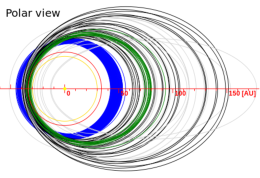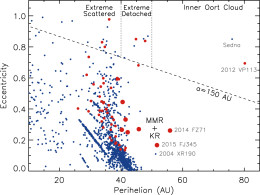What has the search for the hypothetical Planet Nine led to? In the case of this study, the discovery of a collection of new — and puzzling — objects located in the outer reaches of our solar system.

Illustration of the orbits of outer-solar system bodies (with the perihelia co-located on the left for easy comparison). Includes low-eccentricity classical Kuiper belt objects (blue), moderate-eccentricity resonant Kuiper belt objects (green), and high-eccentricity, high-perihelia scattered objects (black). The yellow circle represents Neptune’s orbit. [Created 2006 using the Minor Planet Center Orbit database]
Characterizing the Outer Solar System
The Kuiper belt is a collection of small icy bodies that lies just beyond the orbit of Neptune — but it turns out that Neptune is still a major factor in the shaping of this belt.
Objects in the Kuiper belt fall broadly into two categories: those that orbit between the resonances of Neptune, and those that have been captured into those resonances, likely during Neptune’s outward migration in the past. All of these objects have low or moderate eccentricities and semimajor axes within ~48 AU, making this distance the approximate “edge” of the outer Kuiper belt.
Beyond this distance, objects tend to have much more interesting orbits. These objects have very eccentric or inclined orbits with large semimajor axes and high perihelia (> 40 AU) — and they were likely scattered into these orbits by encounters with Neptune in their past.

Perihelion vs. eccentricity for objects in the outer solar system. Red circles are objects discovered by the authors in this survey; large red circles are the objects specifically discussed in this article. These objects, which have high perihelia beyond the Kuiper Belt edge at ~48 AU but only moderate eccentricity, are likely created by a combination of resonances. [Sheppard et al. 2016]
Distant Discoveries
The team, led by Scott Sheppard (Carnegie Institution for Science), conducted a series of surveys of the outer solar system with new wide-field cameras on the Subaru and Cerro Tololo Inter-American Observatory (CTIO) telescopes.
In their search, they discovered a collection of strange new objects that not only have high perihelia (q > 40 AU), but have also surprisingly low or moderate semimajor axes (50 < a < 100 AU) and eccentricities (e < 0.3). The most extreme of these objects have some of the highest perihelia of objects known in our solar system — and yet they’re not especially distant, unlike similarly high-perihelia objects like Sedna. How did they achieve these unusual orbits?

Semimajor axis vs. eccentricity for objects in the outer solar system. The dashed lines show strong mean-motion resonances with Neptune. [Sheppard et al. 2016]
Resonant Shaping
Sheppard and collaborators use the bodies’ orbital properties to speculate on their dynamical origins. The authors demonstrate that most of these bodies could have arrived at their current orbits due to a combination of two types of resonances: mean-motion resonances with Neptune (in which the objects are driven into orbits with periods that are integer multiples of Neptune’s), and Kozai resonances (in which the objects can be perturbed into higher-inclination orbits).
Based on the discovery of these new high-perihelia objects, the authors argue that a significant population of these objects likely exist. By studying their orbits, we can expect to learn more about Neptune’s history of interactions with smaller bodies, helping us to understand how this giant planet shaped the outer reaches of our solar system.
Citation
Scott S. Sheppard et al 2016 ApJ 825 L13. doi:10.3847/2041-8205/825/1/L13

3 Comments
Pingback: review of new objects beyond Kuiper belt
Pingback: Más allá del Cinturón de Kuiper « SEDA / LIADA
Pingback: A New Dwarf Planet Has Been Discovered and It Could Lead Us to Planet X - UFOholic.com